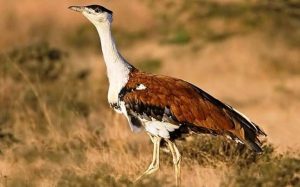Great Indian Bustards Sighted In Pakistan:

The recent sighting of three Great Indian Bustards (GIBs) deep in Pakistan’s Cholistan desert has given rise to speculation that the endangered birds might have flown across the international border from India’s Desert National Park (DNP).
- The Great Indian Bustard, found mainly in the Indian subcontinent, is the flagship grassland species of India.
- It is one of the largest flying birds in the world, and India’s heaviest flying bird.
- The male bird weighs upto 12-15 kg and female bird up to 5-8 kg.
Physical description:
- Black crown on the forehead contrasting with the pale neck and head.
- The body is brownish and the wings are marked with black, brown and grey.
Distribution:
- Its population of about 150 in Rajasthan accounts for 95% of its total world population.
- They are mainly in Jaisalmer district of Rajasthan, including the Desert National Park which is the natural habitat of the species.
- Grasslands of Kutch in Gujarat which is home to second-largest bustard population in India.
- Arid regions of Maharashtra (Solapur), Karnataka (Bellary and Haveri) and Andhra Pradesh (Kurnool)
- It is the State bird of Rajasthan.
Conservation status:
- Listed in Schedule I of the Indian Wildlife (Protection)Act, 1972,
- Listed in Appendix I of CITES,
- Listed as Critically Endangered on the IUCN Red List.




